Accidents involving liquefied natural gas (LNG) and liquefied petroleum gas (LPG) can be dangerous due to their flammable nature. These accidents can result in fires, explosions, and harm to people and the environment. It’s important to handle and transport LNG and LPG with proper safety measures to minimize the risk of accidents.
- The Cleveland, Ohio LNG tank failure – October 1944
- Feyzin refinery and storage facilities – France – 1966
- LPG storage and distribution centre in Mexico City – November 1984
- Two accidents involving LNG tankers
- The EL Paso Paul Kaiser – July 1979
- LNG taurus – 1979
- Accidents involving LPG tankers
- The Yuyo Maru Collision – November 1974
- The gas fountain – Iraq/Iran War – October 1984
- Some other incidents from my own records
- A bad night in Zvetina – Libya
- A few quiet days off the Mexican West Coast
- An example of Brittle Fracture
- A call to Beirut, Lebanon, in March 1976, to Discharge a Part-Cargo of LPG
- An attempt at Jettisoning LNG
Explore real-world accidents involving LNG and LPG storage tanks for insights into safety measures and risk mitigation strategies. Gain valuable knowledge to enсhance industry practices and ensure the safe handling of liquefied natural gas (LNG) and liquefied petroleum gas (LPG) storage facilities.
The Cleveland, Ohio LNG tank failure – October 1944
This is, without doubt, the worst accident involving an LNG shore tank and it is the only recorded accident in the history of the LNG industry to cause substantial loss of life.
The Cleveland site, in Ohio, USA, was the first LNG peak-shaving plant built in the world. The storage facility included three spherical tanks of 2 350 m3 capacity each, built in 1940 and one toro-segmental tank of 4 250 m3 capacity, built in 1943. This tank was of unusual design, being supported by pillars. Although the manufacturers claimed that they had more confidence in determining stresses in a toro-segmental tank than in a spherical tank, problems had been experienced with that tank during commissioning, when a crack developed the first time it was cooled down. Following this, a small bund was constructed around the tanks, designed to contain any small leaks from possible further cracks.
The four tanks were constructed of 3,5 % nickel steel for the inner tank and carbon steel for the outer tank. The insulation was cork and rockwool. The mechanical properties of 3,5 % nickel steel were known to be unacceptable for the LNG temperature of -160 °C, with a great facility to initiate cracking, which could lead to catastrophic failure. However, other more suitable materials were disregarded and 3,5 % nickel steel was used for reasons of wartime shortages and cost saving.
The toro-segmental tank failed catastrophically within a short period of being filled to capacity for the first time. The damage was caused by ground vibration from either a locomotive or a steam hammer, initiating cracking in the brittle tank.
The contents of the tank over-flowed the inadequate bund and entered the common drainage system. Vapour was ignited, most probably from sources of ignition in neighbouring factories and LNG that came in contact with water in the drains caused rapid phase transition explosions, cratering the site. The resulting fire caused the support legs on one of the spherical tanks to buckle and collapse, adding a further 1 000 tons of LNG to the disaster. The remaining two tanks survived the incident intact and without loss of contents.
The main cause of the accident was the wrong choice of materials. The following factors aggravated the disaster:
- Poor site layout and design.
- Undersized bund walls.
- Close pitching of the tanks (3 metres).
- Poorly designed drainage system.
- The proximity of local housing and factories provided sources of ignition and certainly contributed to the high death toll.
This accident resulted in 128 people being killed and between 200 and 400 others injured and stopped the development of peak-shaving facilities in the United States for many years.
Feyzin refinery and storage facilities – France – 1966
The bursting of several large LPG pressure vessels at the Feyzin refinery in France, in 1966, was one of the worst accidents involving Liquefied Petroleum Gas (LPG). The standards for storing and handling LPG were revised in many countries following this incident.
A 1 200 m3 pressurised spherical storage vessel, almost full of propane, was to be drained to eliminate some water. The drain pipe was equipped with two 2″ valves in series. The two valves were opened to proceed with draining. When traces of oil showed that the operation was nearly complete, the valve nearest to the tank was shut and then cracked to complete the procedure. As no flow was coming, the valve was opened fully again. It is presumed that the valve was blocked by a plug of hydrates which was suddenly released, splashing the three operators present with liquid propane. The valve nearest to the tank lost its handle which the operators could not get back on. The second valve froze and could not be moved. The drain valves were located immediately below the tank, which was only 1,4 m above ground, making their access difficult.
A visible cloud of vapour, 1 metre deep, extended over 150 metres. This cloud was ignited 25 minutes after the leak, by a car on the nearby road. The road had been closed by the police, but the car approached via a side road. The fire flashed back to the sphere, which was surrounded by flames. There was no immediate explosion. The sphere was fitted with a water spray, but the supply was only designed to deliver half of the quantity of water normally recommended (8 litres/m2 minute) and this was not sufficient. When the fire brigade started to use their hoses, the supply to the spheres ran dry. The firemen seemed to have used most of the available water for cooling neighbouring spheres to stop the fire from spreading, in the belief that the relief valve would protect the burning vessel. To make matters worse, the ground under the sphere was level so that any propane that did not evaporate or burn immediately, collected under the sphere and continued to burn.
Ninety minutes after the fire started, the sphere burst. Ten of the 12 firemen within a radius of 50 metres were killed. Men 140 metres away were badly burned by a wave of propane coming over the compound wall. Flying debris broke the legs of an adjacent sphere which toppled over. Its relief valve discharged liquid which added to the fire and, 45 minutes later, this sphere also burst. In total, seven spheres and two other pressure vessels burst or exploded and three more were damaged. The fire spread to gazoline and fuel oil tanks. A total of 18 persons were killed and at least 80 others injured.
It was originally thought that the spheres exploded because their relief valves were too small. However, the investigation revealed that the metal in the upper portion of the spheres, above the liquid level, was weakened by the heat and lost its strength. Below the liquid level, the boiling liquid kept the metal cool. Incidents such as this, in which a vessel explodes because the metal gets too hot, are known as Boiling Liquid Expanding Vapour Explosions or BLEVEs. When a tank without insulation is subjected to the heat of a fire, if the liquid level is low and cannot protect the top of the tank by absorbing the heat, the tank walls may overheat and burst at or below the set pressure of the relief valve. The relief valve will not prevent the vessel bursting.
To prevent the occurrence of such incidents, many companies modified the design of tank draining facilities, including, in particular, the fitting of remote-operated valves and combustible gas detectors to provide early warning of a leak. Other modifications were also introduced to prevent a fire from escalating.
Much research has since been conducted on the occurrence of BLEVEs, one of the most frightening accidents which can occur in a fire in an LPG storage facility.
LPG storage and distribution centre in Mexico City – November 1984
In November 1984, a disaster involving an LPG installation occurred in Mexico City and resulted in the deaths of over 500 people. In terms of casualties, this was probably the worst Risks and Compliance for Environment for Liquefied Petroleum Gas Operations within Inland Waterwaysaccident involving liquefied petroleum gases.
The LPG storage and distribution centre, built in 1962, is situated to the North of Mexico City. The storage consisted of four spheres with a volume of 1 600 m3 and two spheres of 2 400 m3, with an additional 48 horizontal cylinders of various dimensions. The pressure relief valves were set at approximately 10,3 bar. The storage location was divided into separate sections by concrete walls, about 1 metre high. The storage centre was supplied by three underground pipelines from refineries and the LPG was distributed in the same way, also via tank cars and gas cylinders. At the time of the disaster, the whole storage centre may have contained 11 000 to 12 000 m3. It was only after construction of the storage site that housing was introduced in the vicinity. The built-up area started some 130 metres from the storage tanks and consisted of simple one and two-storey houses built in brick or wood.
In the early morning of Monday 19 November 1984, a chain of events at the LPG storage facility in Mexico City led to one of the major disasters in the history of industrial activity.
LPG leakage, followed by ignition, caused a number of explosions, which almost completely destroyed the storage facility. Five people were killed and two were injured at the site. The effect in the built-up area south of the storage area was truly dramatic. Approximately 500 people were killed and over 7 000 seriously injured, the majority while they slept. Later, about 200 000 people were evacuated. Between 5,45 a. m. and 7,01 a. m., nine explosions were registered on the seismograph of Mexico City University located 20 miles away. The second and the seventh explosions were the most severe, with an intensity of 0,5 on the Richter Scale. The second explosion occurred within one minute of the first.
Although no direct cause of the accident has ever been officially established, it seems that a large quantity of LPG leaked from a pipeline or a tank. The LPG dispersed over the walls into the surrounding areas and the vapour cloud had reached a height of 2 metres when it was ignited. A flash fire resulted, followed by explosions in various places. The vapour cloud is assumed to have penetrated houses, which were consequently destroyed by internal explosions. The vapour explosion was probably the first of nine that were registered. It caused a huge sea of flames in the storage area. After one minute, a second violent explosion (BLEVE) occurred. A number of reports stated that one or two cylinders were thrown about over large distances. Two spheres may also have exploded at the same time.
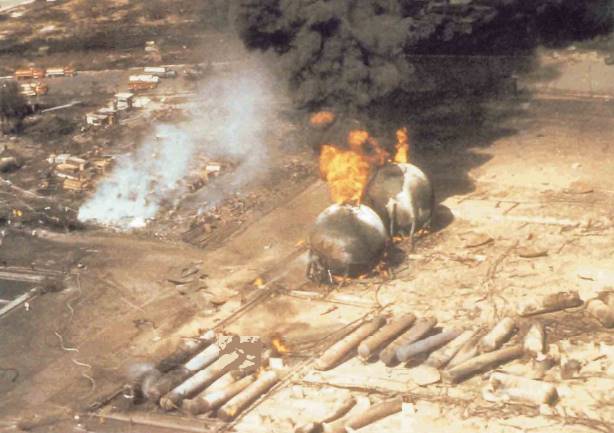
Over-heating and/or penetration by fragments of other tanks were responsible for the BLEVEs. The very short interval between the vapour cloud explosion and the initial BLEVE, if combined with other reasonably reliable information, tends to confirm the supposition that overfill may have occurred in the case of one or more tanks.
The four smaller spheres were completely destroyed, with fragments scattered across the area. The largest spheres remained intact, although their legs had buckled from the heat, causing them to fall to the ground. Only four of the 48 cylinders were left in their original concrete supports. Twelve cylinders were thrown over 100 metres, one landing some 400 metres away and two over 1 000 metres. One large sphere fragment landed at a distance of about 700 metres. The area in which housing was, for the most part, destroyed was the area where the majority of casualties occurred and extended roughly 300 metres from the centre of the storage site.
A lot of lessons were learned from this devastating accident, which was probably caused by a combination of design and operating errors. Standards for the lay-out of storage terminals were modified and the use of mounded horizontal cylinders was strongly recommended.
Two accidents involving LNG tankers
The EL Paso Paul Kaiser – July 1979
On the morning of 29 June 1979, a 125 000 m3 LNG tanker left Arzew, Algeria bound for the East Coast of the United States, with a cargo of 95 000 m3 of LNG. Due to a small defect, Tank № 5 was left empty which explained why the ship was not carrying a full cargo of 125 000 m3.
The cargo containment system was a five tank Gaz Transport Membrane type and the ship was starting her 13th voyage.
On the same evening, shortly before midnight, with reasonable visibility and following a series of unfortunate manoeuvres, the ship became stranded, at a speed of approximately 17 knots, on La Perla Pinnacle, on the north side of the Straits of Gibraltar.
The stranded ship had a forward draft of 16,2 metres, an aft draft of 10,7 metres and a list to starboard of 5,5 degrees. Engineering analysis determined that it would be safe to refloat the ship without transferring the cargo.
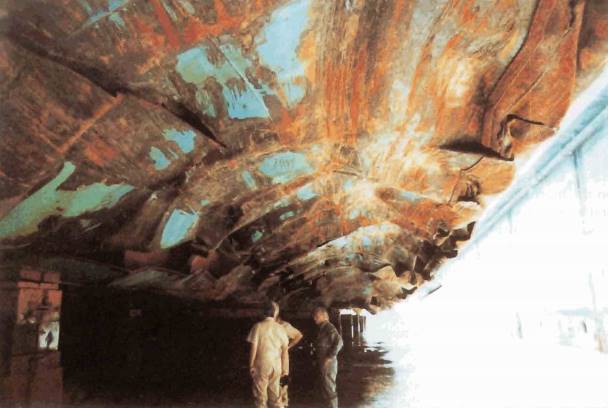
An extensive salvage operation was organised and the ship was refloated on the afternoon of 4 July and was assisted by salvage tugs to a safe anchorage on the west side of Gibraltar.
The decision was made to transfer the whole of her LNG cargo onto a sister ship and the necessary permission was granted by the Spanish authorities. This would be the first time that such a ship-to-ship transfer operation would be attempted between two LNG tankers. Fortunately, a grounding manual had been prepared by the owner the year before, including in the contents a list of material necessary to conduct a ship-to-ship transfer operation.
All the listed specialised equipment, in particular the cryogenic hoses and fittings, had to be purchased and transported to the ship. A wooden platform was built, to be installed between the two vessels. Pneumatic fenders, necessary for mooring the ships together, were found to be available locally.
An assessment of the damage was made, to allow naval architects to establish an unloading plan which would minimise the risk of further structural damage or possible breaching of the inner hull and the cargo containment system.
A balance between several factors had to be made, to obtain a safe discharge sequence.
The main considerations were:
- Minimising the hull stress and bending moment, primarily in way of the damage.
- Maintaining the ship afloat.
- Maintaining the loading manifolds of both ships at approximately the same level.
- Minimising the use of the damaged ship’s ballast system.
Extensive use was made of computer damage stability programmes from the ship’s company head office and of the loading computer on board. In addition, a finite element structural analysis of the ship’s inner bottom was carried out to evaluate its residual strength.
A quite elaborate discharge sequence was designed, combining alternative cargo discharge with water ballast movements, achieved by pressurisation of the water ballast capacities.
The two ships were successfully moored side by side and the Ship to Ship (STS) Preparation and Manifold Connection for Transfer Operationtransfer operation started on the morning of 9 July and lasted little more than 41 hours. The weather remained perfect and a total quantity of 93 161 m3 was transferred at an average rate of 2 250 m3/hour, with no loss of cargo during the transfer.
Following the transfer, the ship was warmed up normally, inerted and aerated in preparation for proceeding to a repair yard.
Despite this extensive damage, the cargo tanks remained intact and the only consequences were damage to the secondary membrane at the after part of Tank № 1 forward part of Tank № 2 and disformation of the primary membrane on the after part of No. 1 Tank. Fortunately, Tank No. 1 remained liquid tight and there was no leakage of LNG (See Fig. 3).
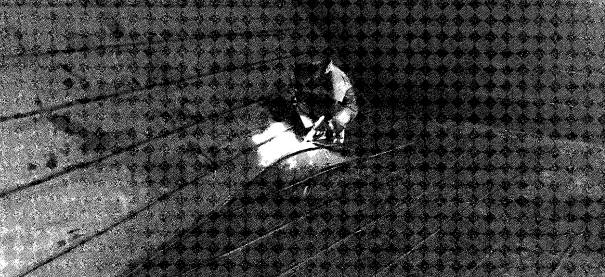
Repairs were completed in January 1980 and the ship was then ready to re-enter service.
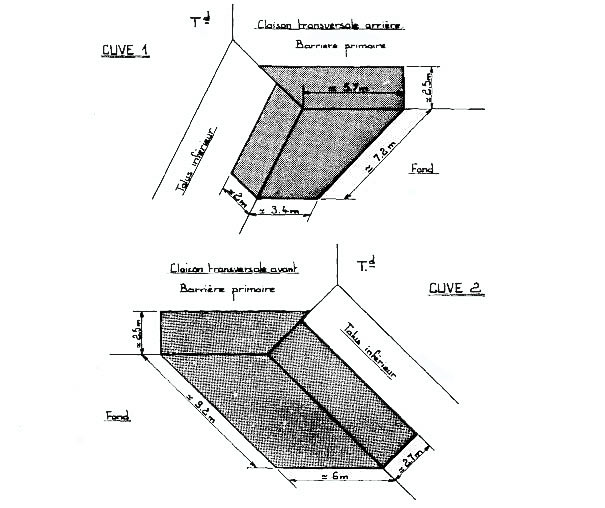
LNG taurus – 1979
Late in 1979 LNG «Taurus», a 125 000 m3 LNG tanker with a cargo containment system of the five tank Kvaerner-Moss self-supporting spherical type, was bound for Tobata, Japan with a full cargo of LNG from Indonesia. The LNG Taurus and her sister ships had discharged in this port many times since 1977, when the Indonesia to Japan project started and the crews were very familiar with the port and the usual procedures in force. Arrival at the pilot station was scheduled for early morning as usual and it was common practice, in case of bad weather, for the ship to pick-up the pilot inside the protected waters of the bay.
On that particular day, the weather was slightly rough but no special warning had been received and the Master was anticipating a routine discharge. However, when the vessel entered the bay, expecting to pick up the pilot at the usual location, they were told that the terminal was closed and that the ship should stay outside until further notice. Unfortunately, the ship was already too far inside the bay to be able to turn around without entering. They attempted to turn inside the bay but eventually ended up stranded on solid rocks, at a speed of approximately 12 knots.
The ship’s bottom sustained extensive damage but, fortunately, the cargo containment system remained intact and after successful salvage and discharge of the cargo, the ship was dry-docked for repairs. The damage resulting from the grounding was almost completely to the outer shell of bottom plating and the stiffeners between the inner and outer hulls. There was very little deformation of the inner hull and no deformation to any of the tank support structures or the tanks themselves. Slightly more than 2 000 tonnes of steel had to be replaced.
These two last incidents are the only serious accidents involving LNG tankers. In both cases, with two different cargo containment systems, despite very serious damage to the ship’s hull, the integrity of the cargo containment was not affected and no casualties were directly attributable to the accident.
Accidents involving LPG tankers
The Yuyo Maru Collision – November 1974
This was probably the worst List of the Emergency Situations which can happen on the Liquefied Gas Carrieraccident involving a liquefied gas tanker. On 9th November 1974, the LPG tanker Yoyu Maru, Japanese flag, built in 1966, with approximately 47 200 m3 of LPG tank capacity, was proceeding through the Tokyo Bay to Kawasaki, to discharge a cargo of propane, butane and naphtha loaded in Ras Tanura, Saudi Arabia. The ship was designed to carry refrigerated propane and butane in special LPG tanks and naphtha in the side ballast tanks and the forward deeptank. Although this configuration is not allowed by the IMO IGC code, the code only applies to ships built after 1980. In this instance, the ship was loaded with 35 553 m3 of fully refrigerated propane, 10 796 m3 of fully refrigerated butane and 35 553 m3 of naphtha. The ship was proceeding at about 12 knots, assisted by an escort boat, in accordance with local regulations.
The cargo ship «Pacific Aries», Liberian flag, built in 1968, 10 874 gross tons, loaded with 14 835 tons of steel materials, had just left the port of Kisarazu in the Tokyo Bay and was proceeding towards Hokkaido at a speed of about 7 knots. The weather was good, with two miles’ visibility.
At about 13,37 hours, the bow of the «Pacific Aries» struck the starboard bow area of the «Yuyo Maru» almost at a right angle. On the «Yuyo Maru», one of the naphtha tanks was damaged, resulting in the escape of a large amount of naphtha which immediately caught fire. The «Pacific Aries» had her bow crushed and was instantly covered with the burning naphtha coming from the «Yuyo Maru». As they were in the middle of the traffic lane, both ships were towed to other areas of the bay. The «Yuyo Maru» was stranded and the «Pacific Aries» was anchored.
On the «Pacific Aries», the fire was reasonably under control at about 17,00 hours the same day. Due to the extreme intensity of the blaze, 27 crew members died almost immediately following the collision. The only survivor was the second engineer who stayed in the control area of the engine room wearing a breathing apparatus during the worst of the fire. He was only discovered the next morning.
On «Yuyo Maru», 5 members of the crew of 38 were killed and 7 were injured. The flames were estimated to be 60 metres high, black smoke billowing to 300 meters. Despite the rapid arrival of fire-fighting facilities, access on board was impossible due to the extreme heat and the fire continued unabated for many days, with some large explosions sending flames higher than 100 metres. Eventually, the fire extended to reach more naphtha tanks on the starboard side. The LPG tanks remained intact until 13th November, when gas started burning on top of the level gauges and the manholes. On 20th November, the fire was still active and the vessel was towed out of the Tokyo Bay. The vessel was 23 nautical miles offshore on the afternoon of the 21st when fire and explosions became so fierce that it was decided to abort the towing operation. The vessel was left to drift and continued burning until 27th November, when it was decided to sink it. Even this was not easy and it took two days of bombing by four ships and four planes, along with torpedo attacks by a submarine to eventually send the ship to the bottom on 28th November in the afternoon, 18 days after the collision.
It is interesting to note that, despite the raging inferno created by the burning naphtha, it took five days for the fire to start affecting the LPG tanks. Prior to that, LPG vapour was only burning at the top of the safety valve masts.
Following the accident, the rules of navigation in the Tokyo Bay were reviewed and, more importantly, the design of LPG tankers allowing the transport of petroleum products in the side tanks was forbidden.
The gas fountain – Iraq/Iran War – October 1984
During the 1980’s the Iran/Iraq conflict took a large toll on shipping in the Persian Gulf. Gas tankers were more fortunate and one of the few to be hit was a 40 232 m3, fully refrigerated LPG carrier built in 1969. The ship can be considered as one of the first generation of fully refrigerated LPG ships.
This was the first occasion that a liquefied gas carrier was breached with ensuing fire and then successfully salvaged. This incident provides a practical demonstration of the sound design concepts of these vessels.
The ship is a conventional LPG ship, designed with three free-standing prismatic cargo tanks, able to carry fully refrigerated propane and other liquefied gases of similar characteristics. Each tank is surrounded with loose perlite insulation and is contained in a hold surrounded by side and bottom water ballast tanks. Each hold and the engine room are separated by Cofferdam – Definition and Pronunciationcofferdams.
Each tank is equipped with two submerged electric pumps located at the aft part and one electric deepwell pump located at the centre. The cargo liquefaction plant is installed in a single deck house, amidships. A cargo control room is located within the fore part of the all-aft accomodation.
The ship had loaded 6 300 tonnes of propane in tank № 1 and 12 140 tonnes of butane in tanks № 2 and 3 at Ras Tanura and sailed on 11th October 1984 for Fujairah outside the Gulf.
During the morning of 12th October, when in the middle of the Gulf, the ship was stalked by an Iranian aircraft which subsequently attacked with air-to-ground armour piercing rockets. Three rockets hit the vessel.
The crew, understandably, promptly operated the cargo emergency shut-down system, stopped the ship’s engine, closed doors between accommodation and engine room and abandoned ship in the life boats. They were subsequently rescued and returned home without injury.
One rocket exploded on-deck, above the fore end of tank № 2, near the centre line. The deck was breached in two places but tank № 2 was undamaged. All piping and electric cables above deck were damaged and some liquid cargo was released and caught fire.
The other two rockets hit the deck on the aft port side of tank № 3. One apparently exploded above deck, doing little damage. The other penetrated the deck at an oblique angle and travelled some 4 to 5 metres forward in the hold space above the cargo tank before detonating. The explosion lifted a section of the deck and also opened the tank roof over an area of about 3×2 metre. This tank was full of butane which, during its initial and continued release, established a large fire on deck above the shell entry hole. It has been estimated that some 220 m3 of liquid butane was released during the initial depressurisation of the tank. This probably lasted for the first 60 minutes after the initial penetration. During this first phase, the fire was similar in characteristics to a large turbulent torchlike flame, reaching heights of up to 200 metres and creating heat damage on deck. Thereafter the fire stabilised, being fed by gas boil-off escaping through the hole in the tank.
Openings in the accommodation house probably due to shattered windows and the high thermal radiation occurring in the first stages of the fire, led to the ignition of multiple fires which completely gutted it. The fact that doors between the accommodation house and the engine room were found closed, probably prevented the fire spreading through the engine room. However, all electric cables on deck and in the accommodation were completely destroyed.
This was the situation when the salvage tug made contact with the ship on 13th October. After intensive water cooling of the main fire areas, the gas fires were extinguished with powerful water jets, first over tank № 3 and then the torch fire over tank № 2.

Although this is contrary to the usual advice not to extinguish gas fires, in this instance it was necessary, as there was no possibility of isolating the leaks. Had the ship been left to float around, the fires would have continued burning until the whole cargo was consumed.
The vessel was then taken in tow towards Dubai, to escape from an area of possible further aerial attacks and to prevent gas build-up now that the fires were extinguished. A salvage team was put together and started the comprehensive and complicated task of preparing the vessel for transhipment of the cargo. The following actions were taken:
- Securing the vessels gastight integrity.
- Control of the cargo tank pressures.
- Establishing a controllable trim and list situation.
- Reactivation of the electrical supply and essential services from the engine room.
- Repair of the fire protection and fire-fighting systems.
- Preparation of cargo pumps and cargo piping for transhipment.
- Preparation of a transhipment schedule.
Finally, on 15th November 1984, just one month after the attack, all the remaining cargo was successfully transferred onto another vessel.
The quantity of cargo transferred was 17 204,2 tonnes of propane and butane. The total quantity lost during the incident was therefore about 1 200 tonnes. The quantity lost during the attack and subsequent venting during the next ten days was estimated at 350 tonnes. Thereafter, once the tanks were reinstated in a tight situation, manual venting was continued to control the tank pressure. The quantity vented was estimated as follows:
- Tank № 1 with propane: 12-13 tonnes/day.
- Tank № 2 partly full with butane: 8 tonnes/day.
- Tank № 3 with butane: 7-8 tonnes/day.
It is interesting to note that, even after such a serious attack, the damage to the LPG tanker was such that most of the cargo could be saved and the ship was eventually left in a repairable condition.
Some other incidents from my own records
A bad night in Zvetina – Libya
Sometime during the winter of 1974, a ship, which was part of the fleet for which I had the technical responsibility, was loading LPG in Zvetina, Libya. The ship was a five year old, 9 000 m3 semi-pressurised LPG tanker. Her schedule was to complete loading in the evening and depart immediately for the discharge port. In the middle of the night, I was awakened by a call from the ship’s captain via the radio-telephone, advising that, while leaving Zvetina in good weather and good visibility and with the assistance of a local pilot, the ship had missed the turn at the end of the channel and was grounded by the bow on the rocky bottom at the side of the channel. The rest of the night was occupied with establishing, with the ship’s crew, that their situation, although regrettable, was not immediately critical and with setting in motion the Company Emergency Procedures. As the ship’s position was not critical and the weather forecast reasonable, it was decided to try to get the ship free at high tide under her own power. Unfortunately this was not successful but, at the tide coefficients were on the increase, it was decided to try again at the next high tide. There was already a tug outside, offering salvage but, as yet, there was no urgency.
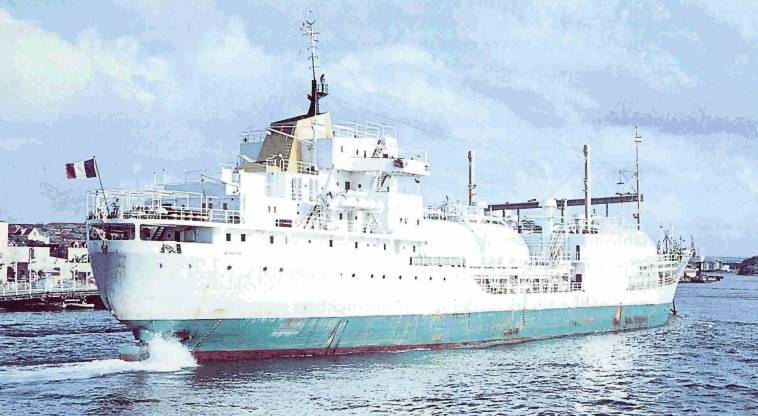
A small ship had been chartered to attempt a trmshiprrtent of part of the cargo but, it was risky to carry out such an operation in the channel, particularly with the swell which was consistent with a tendency to increase. The ship was labouring on the rocks and it was obvious that something would have to be done soon to amid further damage.
The possibility of venting part of the cargo was discussed with the show authorities and authorisation was apparently received from none other that Colonel Gadafi himself. However, this was also difficult in view of the proximity of the refinery which would need to be shut down for the duration of the operatian. Time and high tides went by until suddenly, after six days, with one wave stronger than the others and the engine full astern, the ship decided to leave the racks and remain afloat, albeit with a very substantial negative trim. This was sufficient to take her to anchor outside and to organise a ship-to-ship transfer onto the little ship which bad been waiting this time. Two thousand tomes of cargo were transferred and a second ship was waiting to take the rest. Unfortunately, the weather was worsening and a second ship-to-ship transfer operation became too dangerous. Stress calculations having confirmed that the ship could safely sail, authorisation was obtained from the classification society for the two ships to make their way together to Pireus, Greece, where the rest of the cargo was transferred and the damaged ship repaired.
This created an unexpected windfall for the Pireus customs officers and for the load cement transport company. The cargo tank insulation was bulk perlite and the perlite had to be removed from the forward hold to repair the ship’s bottom. As the perlite was wet, it had been transformed into a whitish muddy substance which needed to be pumped out and disposed of. The local authorities allowed its transport to the City refuse dump and the cement transport trucks were ideally equipped for this. However, the customs officers were highly suspicious of this white powdery substance, even in its very muddy condition and they insisted that each truck be accompanied to the refuse dump by a customs officer. Thus, a worrying episode ended on a lighter note.
A few quiet days off the Mexican West Coast
In 1975, a new addition was made to the fleet for which I had the technical responsibility. This was a 35 500 m3 LNG tanker, with a containment system of the Gaz Transport membrane type. The ship was also equipped with reliquefaction equipment to enable her to transport LPG and ethylene.
After delivery from the shipyard at the beginning of 1975, the ship completed successful cargo trials at the LNG terminal of Barcelona, Spain and, as there was no opportunity for a cargo of LNG, she was ordered to load a full cargo of LPG in Arzew, Algeria for Japan. This was the time when the Suez canal was blocked and the most convenient route was therefore through the Panama Canal.
Already, on arrival at Cristobal, there was a call from the Captain, who was being threatened with jail by the port authorities, following the spillage on deck of approximately 50 litres of fuel at the end of bunkering. A guaranty of 1 000 US Dollars was arranged via the agent, which allowed the Captain to return on board and the ship to continue her voyage.
Two days later, there was another radio call, this time explaining the troubles the Chief Engineer was experiencing with the fresh water evaporators. One evaporator was definitely out of service and the other one was being cleaned. Due to some unexpected purging required, following the malfunction of the evaporators, there was only sufficient fresh or distilled water left on board to proceed for another 12 hours, during which time the second evaporator would be put back into service and hopefully produce more water. However, should the second evaporator also fail, the boilers would have to be stopped. The ship was 200 miles off the coast of Mexico with no nearby traffic and a good weather forecast. It was agreed to resume communication in twelve hours.
The next radio conversation established that there was no fresh or distilled water left on board, the second evaporator was not producing any water and the boilers had been stopped to avoid any serious tube damage due to water starvation. The situation of the ship was reassessed and, again, found to be reasonably safe. There was no traffic to speak of, the weather forecast was good and the vessel was slowly drifting off shore. Tarpaulins had been laid to collect rain water for domestic consumption and the captain and crew were prepared to bide their time in this situation.
The Company Emergency Team was promptly assembled and alternative solutions envisaged. Eventually, it turned out that one LPG ship under charter to our company was just passing through the Panama lakes. That ship was asked to load some fresh water from the lakes, which is suitable for use in boilers, into her ballast tanks to deliver to the drifting ship.
Three days later, the two ships met, transferred the water and the situation returned to normal. The LNG tanker was sent to Acapulco to pick up the service representative for the fresh water evaporators and then sailed to Los Angeles where more serious repairs were arranged before continuing the voyage to Japan where the cargo was eventually safely discharged.
The reason for this incident, which could have led to a much more serious situation, was the engineering crew’s lack of familiarity with the type of fresh water evaporator in use on the ship. This was eventually corrected through some intensive training and some crew reshuffling.
An example of Brittle Fracture
Sometime during the eighties, a ship was discharging LNG in a well known European terminal. For an unknown reason, one liquid valve was not completely closed and when the pumping started, part of the LNG, instead of going ashore as expected, found its way up mast no. I and overflowed on to the deck. It took a few minutes for the crew to realise what was happening, by which time the damage was done. The amount of liquid spilled was probably no more than 30 or 40 cubic metres, but the results were spectacular. (See Fig. 7).
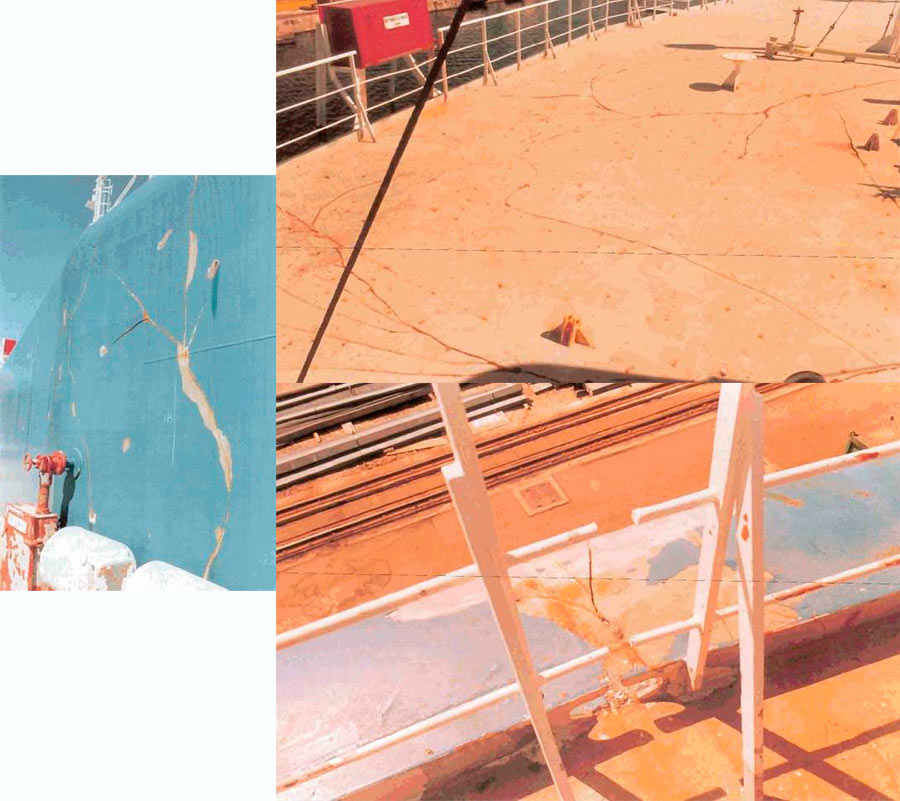
This sort of incident is an ever-present risk for crews operating LNG, and to a lesser extent LPG, ships. Warnings about the risk of brittle fracture are a basic part of their training. However, as the cargo remains mostly within the completely closed piping network, it can be difficult to visualise the kind of damage that a few litres of liquid can do to normal steel. The following photographs show enough to illustrate the danger of such an incident and the extent of the damage which can result in but a few minutes.
A call to Beirut, Lebanon, in March 1976, to Discharge a Part-Cargo of LPG
The very brave superintendent involved in this adventure, a good friend of mine, was sent to Beirut by the company to supervise the discharging operations of a 12 000 m3 semipressurised LPG tanker. He received a hint of things to come when, on arrival at Beirut airport, he found that the only way to board the shin off-shore was be rowing boat.
In Beirut, LPG was normally discharged through sea-lines. There were three sea-lines in use, but at that time there was also a war going on between:
- Christian militias;
- Palestinians;
- and Islamic activist groups.
Beirut port was in flames and it was impossible to anchor near by the first sea-line. The third sea-line at Djouniye, in the Christian area, was under constant fire from heavy guns. The only possibility was the intermediate sea-line between Beirut and Djouniye, which was subjected to only sporadic fire from light guns. The ship was moored across with two anchors and the sea-line connected with the assistance of two local helpers in a rowing boat.
The use of all radio contact was prohibited and communication with the small terminal onshore could only be carried out by flag or light signals.
Read also: The business of LNG and historical involvement in maritime transportation of gas
Discharge started and, at first, all went well. But when it was time to stop, the terminal no longer answered. Night was falling and the ship had already suffered a few hits on the poop deck, in the tank insulation and even one in the pump room bulkhead. It was necessary to go ashore to advise the terminal that discharge was complete, and that the pipe would be disconnected after having been purged under pressure and to obtain an acknowledgement of the quantity discharged.
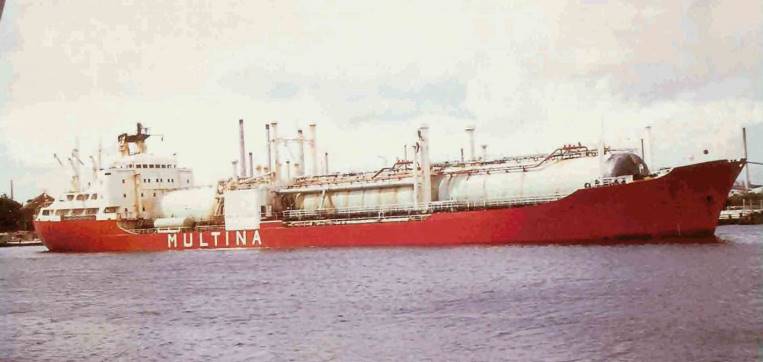
The superintendent used the two local helpers and their rowing boat to reach the shore, where he had to take cover crawling beside a raiway track using the carriages as protection from the shooting in progress. Twice he was stopped by armed militia, though he had no way of knowing to which side they belonged. They took him under armed guard to the terminal where he got the necessary documents signed. They brought him back along the same railtrack, still under armed guard, but this time, walking upright, to the small boat which took him back on board. The ship sailed that night and his final comment was that «no lights were necessary as the bay of Beirut was all aglow and burning».
An attempt at Jettisoning LNG
In most safety manuals written for LPG or LNG tankers, jettisoning cargo is given as the solution to be adopted to lighten the ship in case of a stranded vessel and all ships are equipped with a jettisoning nozzle. This might give the non-informed reader the impression that, in the most desperate situation, there is still something which can be done. However, the way to proceed to jettison a cargo of LPG or LNG is very much unknown. Some reasonably successful trials were carried out by a large oil company on one of a series of LNG ships built in the 1970’s. However, those ships were equipped with a stern discharge line, which made the operation quite different from jettisoning to be done on the ship’s side from cargo manifolds located amidship.
In December 1981, we had just completed the cargo trials of a newly-delivered 130 000 m3 LNG tanker, with a five tank Gaz Transport membrane type containment system, in Arzew, Algeria. Due to a delay in the start of the project, the ship had to be laid-up for one or two years and had to be gas-freed before being taken to the lay-up site. At the end of the cargo trials, approximately 900 m3 of LNG remained in the tanks and this product had to be vaporised or otherwise disposed of before arrival at Canvey Island where the ship was to receive nitrogen to gas-free the cargo containment system. (The ships of this series are not equipped with inert gas generators and have to rely on an outside supply of nitrogen for gas-freeing).
On Friday 4th December, the ship was approximately 40 miles North West of Cap Finistere in the Bay of Biscay. There was no traffic within a radius of 20 miles or more and the wind had increased to force 8 (25 to 30 knots). After consultation with our Head Office, it was decided to proceed with the jettisoning of the remaining cargo, as an experiment to find out if such an operation could really be successfully achieved.
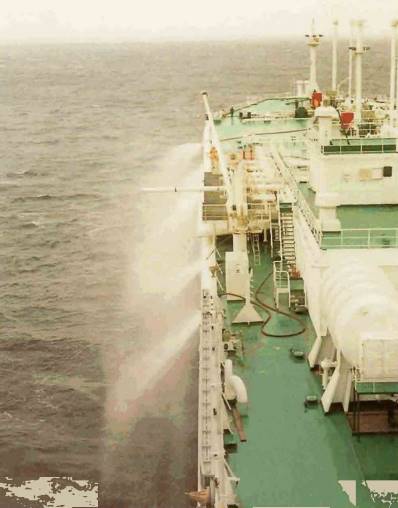
The following precautions were taken:
- All doors and windows of accommodation and machinery rooms were closed and all air conditioning systems put on 100 % recirculation.
- A constam flow of water was arranged along most of the port side of the hull with a combination of fire hoses and the permanent water spray system.
- A constant monitoring of gas concentrations was arranged on all deck areas and in the accommodation with fixed and portable gas analysers.
- All senior officers were at their respective posts of responsibility and were in constant communication through portable radios.
The ship was maintaining a course of 350 degrees at a speed of 14 knots and the wind was from the North-East. At 10-30 hours, after installing the jettissoning nozzle, the cargo piping was pressurised with one cargo pump in service and the manifold valve was opened.
As soon as LNG started to flow through the jettison pipe it was obvious that vapour from the vaporised liquid was coming back alongside the ship instead of being dispersed away, and the operation was stopped.
Due to the ship’s high superstructures, an area of low pressure was created towards the aft part of the hull on the side opposite to the wind and the LNG vapour was attracted to this area.

It was not possible to jettison cargo safely in these conditions. After a debriefing, it was decided to have another try in the afternoon, with the ship in a different position in relation to the wind.
The operation was repeated at 14-00 hours, with the ship sailing a course of 260 to 280 degrees at 3 to 4 knots, with the wind, still 25 knots, coming from aft or three-quarter starboard side. After a few minutes of pumping LNG out in these conditions, the vapour cloud was again starting to come alongside the ship and the operation was stopped once again.
The next try was made with the ship in the same position but stopped or going astern at 1 knot. The original idea was for the ship to steam astern, but it was not possible to steer the ship with enough accuracy to guarantee a stable position relative to the wind.
In this way, it was found to be possible to pump the LNG out with the vapour cloud following the wind forward of the ship. The end of the jettison pipe was 17 metres above the water. When pumping with one pump at an estimated flow of 1 200 m3/hour, the liquid flow was almost totally vaporised before touching the water.

A second pump was started and the flow increased to about 2 000 m3/hour. Then the liquid LNG was seen touching the water and some very strong explosion noises were noticed. The second pump was stopped. The operation was continued until 16-00 hours. An estimated 700 m3 of LNG had been jettisoned and the quantity remaining on board could only be pumped out with the stripping pumps.
During the whole pumping operation, the flow of liquid was maintained at approximately 10 metres away from the hull and the white cloud of vapour was flowing towards the forward part of the ship, barely touching the port-side deck. The gas analysers were showing 50 % of LEL at the fringe of the cloud.
The operation had finally been possible but the main engine and the steering had to be used constantly to maintain the wind coming from aft of the ship and to maintain the flow of liquid as far as possible from the hull. It would probably be quite difficult to continue pumping in these conditions during the time it would take to empty a whole cargo, particularly if the wind was not as strong as it was that day. For a stranded ship, the chances of being able to jettison cargo safely without being able to control her position relative to the wind would be very slim.
Fortunately, the safety record of liquefied gas tankers is extremely good and we have seen that, even with very serious damage to the hull, the cargo containment remains intact.
The explosions which were heard when the flow of LNG was increased were probably due to the phenomenon of Rapid Phase Transition (RPT) which occurs when «old» LNG enters into contact with water. The LNG pumped out during this experiment had been transferred from tank to tank during cargo trials and had probably lost a certain amount of its lighter components. It could be qualified as «old».
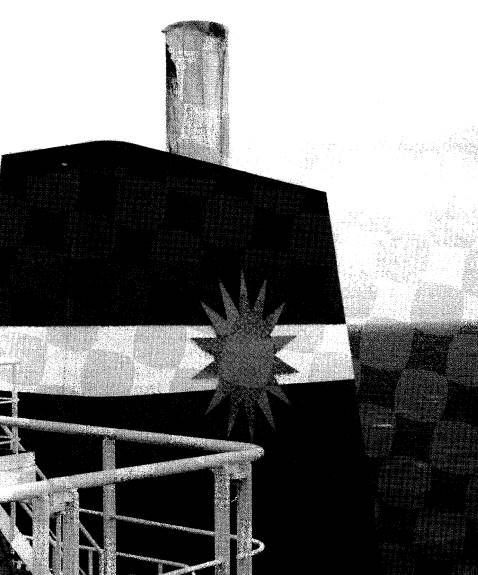
Enough stories for now. It would not be difficult to keep going though! There is never a dull moment when operating liquefied gas tankers. This is what makes it so interesting. I did it for twenty-five years and would be ready for another twenty-five!
